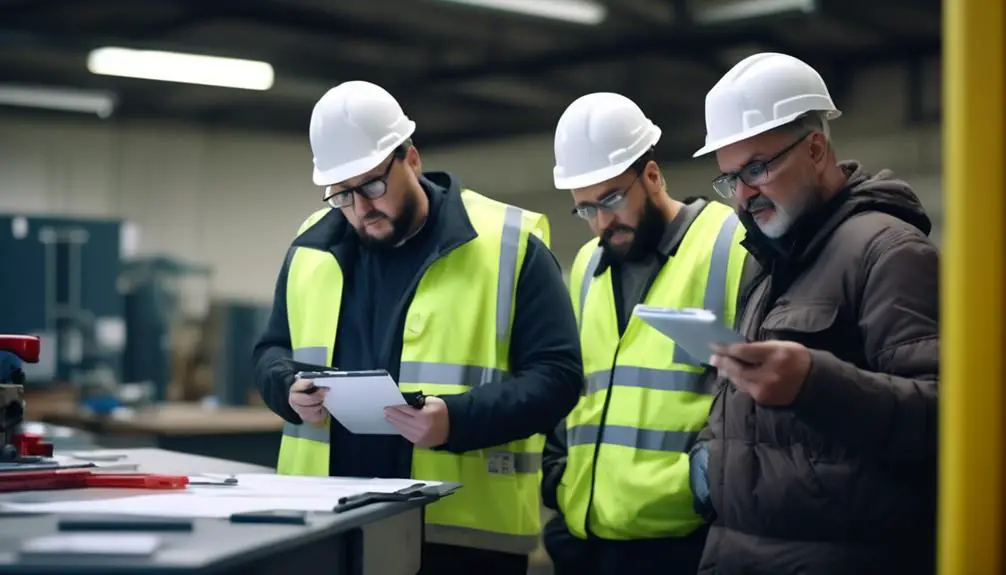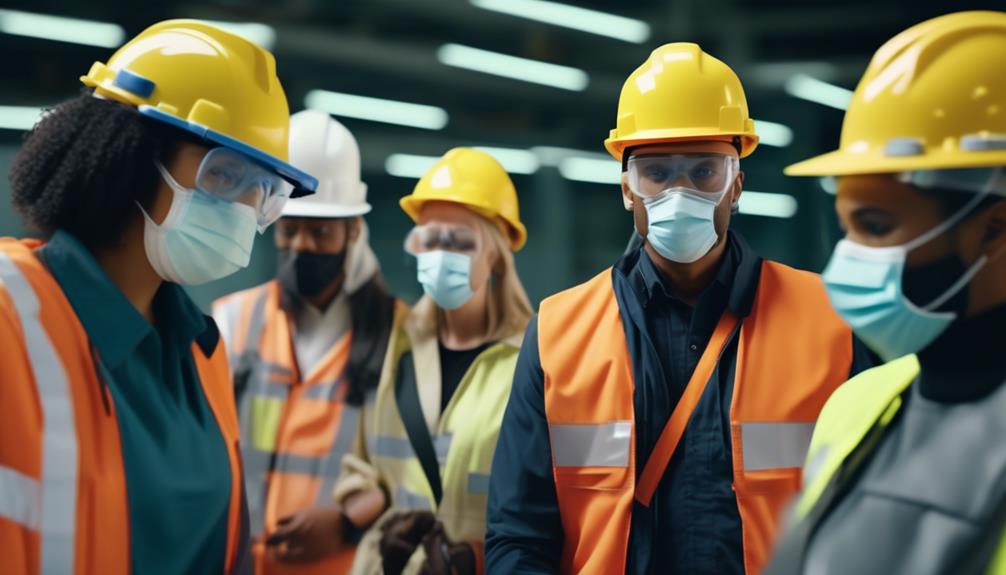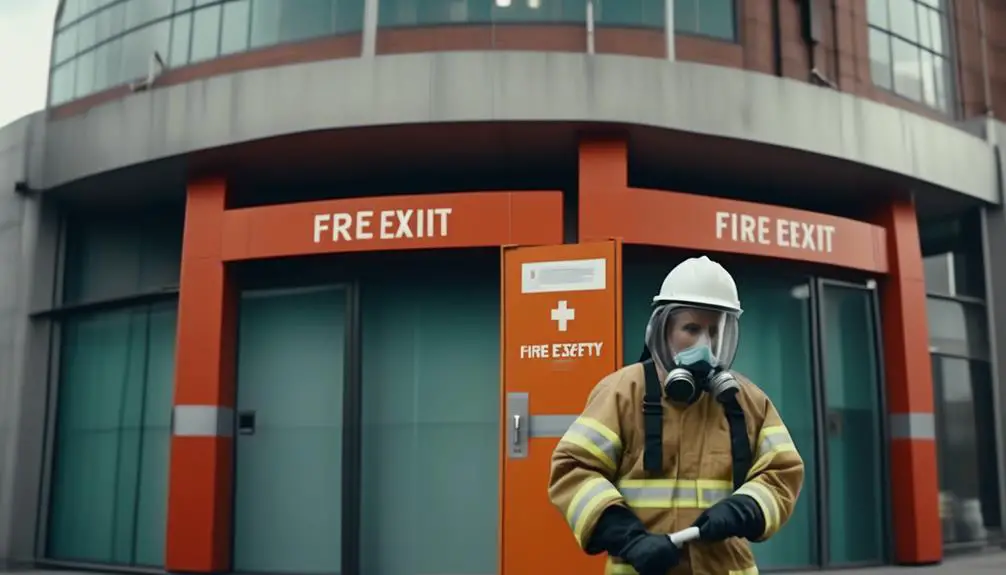The balance between productivity and safety is crucial in the dynamic environment of Southall. Maintaining a healthy work environment involves understanding and implementing health and safety policies effectively. Neglecting these guidelines can have far-reaching implications, so it's essential to consider the intricacies of health and safety regulations.
Join us as we explore the essential components of Southall's health and safety landscape, uncovering strategies to ensure the well-being of our workforce and the success of our endeavors.
Importance of Workplace Safety
Workplace safety is vital for protecting employees' well-being and ensuring compliance with regulations. At Southall, we prioritize safety culture and effective risk management to create a secure and valued work environment for every team member.
Our commitment to safety culture means that each person takes responsibility for their own safety and that of others, fostering a sense of belonging and unity among our staff.
Effective risk management is at the core of our safety practices. We regularly assess potential hazards, implement proactive measures to mitigate risks, and provide thorough training to equip our employees with the knowledge and skills to navigate their work environment safely.
This attention to detail ensures regulatory compliance and instills confidence in our workforce, knowing that their well-being is a top priority.
Understanding Health and Safety Regulations
It's crucial to comply with regulations in our workplace to ensure the safety and well-being of all employees.
Understanding health and safety rules is essential for maintaining a secure and healthy work environment.
Adhering to these regulations is important for preventing potential hazards and promoting a culture of safety.
Regulatory Compliance
Understanding health and safety regulations is crucial for ensuring compliance and creating a safe work environment. Staying updated on regulatory changes and addressing compliance challenges is vital. Non-compliance can have serious consequences, making compliance training essential for all employees.
It's our collective responsibility to uphold these standards and prioritize safety. We must actively participate in compliance training to understand the details of regulations and how they apply in our work environment. By doing so, we not only protect ourselves but also contribute to the overall safety and well-being of our colleagues.
Let's foster a culture of compliance, where we're all committed to upholding health and safety regulations. Together, we can create a workplace where everyone feels secure and valued.
Workplace Safety
Maintaining a safe and efficient work environment requires strict adherence to health and safety regulations. It's crucial to identify and address workplace hazards to prevent accidents and injuries. Regular safety inspections and risk assessments help recognize potential dangers and implement effective safety protocols.
By actively involving employees in safety procedures and providing thorough training, we can establish a culture of awareness and responsibility. Promptly reporting and addressing safety concerns is vital for ensuring a safe workplace. Keeping safety protocols up to date and ensuring all employees are familiar with them is equally important.
Prioritizing workplace safety not only ensures compliance with regulations but also fosters a sense of belonging and well-being among our team, leading to a thriving and secure work environment.
Implementing Effective Risk Assessments

Implementing effective risk assessments is crucial for maintaining a safe workplace. It involves a comprehensive approach that considers various factors to mitigate risks and ensure regulatory compliance. Here are some key considerations for implementing effective risk assessments:
- Clear Communication: Ensure that all employees are well-informed about the identified hazards, safety protocols, and risk mitigation strategies.
- Regular Monitoring: Regularly monitor the implementation of risk mitigation measures to ensure their effectiveness and make adjustments as necessary.
- Employee Involvement: Encourage active participation from employees in the implementation of risk assessments, as they often have valuable insights into potential hazards.
- Documentation: Maintain thorough documentation of risk assessments, including identified hazards, implemented safety protocols, and any changes made to mitigate risks.
Developing Comprehensive Health and Safety Policies
In order to comply with regulations and ensure clear communication, we carefully create detailed health and safety policies that prioritize attention to detail and adherence to best practices. Developing these policies is crucial for fostering a strong safety culture within our organization.
Our policies are meticulously crafted to reflect our commitment to the well-being of our employees and the community. We understand the importance of using clear and simple language in our policies to ensure that every individual understands their rights and responsibilities regarding health and safety.
Our approach to policy development involves thorough research and consultation with industry experts to stay updated with the latest regulations and best practices. We aim to create policies that resonate with our employees, fostering a sense of belonging and shared commitment to safety. By involving our team in the development process, we ensure that the policies are relevant and practical in real-world scenarios.
Furthermore, our comprehensive health and safety policies are regularly reviewed and updated to align with any changes in regulations or industry standards. This iterative approach reflects our dedication to continuous improvement and our unwavering commitment to maintaining a safe and healthy work environment.
Essential Training Programs for Employees

As part of our commitment to maintaining a safe and healthy work environment, it's crucial to develop and implement essential training programs for employees. These programs play a vital role in equipping our workforce with the necessary knowledge and skills to adhere to safety protocols and contribute to a culture of workplace safety.
We regularly conduct interactive workshops covering various safety topics to encourage active participation and enhance knowledge retention among employees. Additionally, our employees undergo scenario-based training to simulate real-life safety challenges, enabling them to apply safety protocols in practical situations. Continuous learning modules are also provided to ensure that employees remain updated on the latest safety standards and procedures.
Furthermore, we value feedback from our employees on the effectiveness of the training programs, which promotes continuous improvement and engagement.
Maintaining a Culture of Safety
In order to maintain a culture of safety, we consistently emphasize the importance of following safety protocols through regular communication and training. This ensures that all employees are actively involved in promoting and maintaining a safe work environment.
Continuous improvement is crucial for sustaining a strong safety culture. By actively engaging employees in this process, we encourage a sense of ownership and responsibility for safety within our organization. Our safety communication strategy includes regular updates, reminders, and open forums for employees to share their concerns and suggestions. This creates a platform for open dialogue and feedback, which further strengthens our safety culture.
Employee Engagement Benefits and Impact on Safety Culture:
- Enhanced morale and teamwork fosters a sense of unity and belonging among employees.
- Improved hazard identification and reporting encourages proactive hazard identification and reporting.
- Increased safety compliance and participation promotes a culture of accountability and responsibility.
- Strengthened safety leadership and mentorship cultivates a culture of mentorship and knowledge sharing.
Through these efforts, our goal is to create a workplace where every individual feels valued and empowered to actively contribute to our collective commitment to safety.
Frequently Asked Questions
What Are the Specific Health and Safety Regulations That Apply to the Southall Area?
We conduct regular workplace inspections to make sure we're following the specific regulations for health and safety set by the local authority. It's crucial to stay updated on these rules to keep our work environment safe.
How Often Should Risk Assessments Be Reviewed and Updated in the Workplace?
In the workplace, it's crucial to regularly review and update risk assessments to ensure ongoing safety. Identifying and addressing workplace hazards is a top priority for our team, which is why we conduct frequent assessments to maintain a safe environment for everyone. This approach helps us stay proactive in preventing potential risks and promoting the well-being of all individuals in the workplace.
Are There Any Industry-Specific Health and Safety Policies That Businesses in Southall Should Be Aware Of?
It is important for businesses in Southall to prioritize workplace safety by following industry-specific regulations. This includes compliance measures, risk assessment, employee training, and maintaining a safety culture. These measures are crucial for ensuring the well-being of the team and the community. By adhering to these policies, businesses can create a safe and secure environment for their employees and contribute to the overall health and safety of the community.
What Are the Key Components of the Essential Training Programs for Employees in Southall?
Essential training programs for employees should focus on creating a safe work environment, developing necessary skills, and ensuring compliance with regulations. Employee development is vital for fostering a secure and efficient workplace.
How Can Businesses in Southall Ensure That a Culture of Safety Is Maintained Over Time?
Maintaining a culture of safety in businesses over time requires actively involving employees in safety measures, continuously improving processes, and ensuring compliance with regulations. This helps create a sense of belonging and accountability in the workplace.
Conclusion
Workplace safety is vital for the well-being of employees and the success of our business.
Effective safety programs can significantly reduce workplace accidents.
Understanding and complying with health and safety regulations, conducting thorough risk assessments, and providing ongoing training are essential to maintain a culture of safety.
Prioritizing the health and safety of our team creates a secure and productive work environment.







No Comments